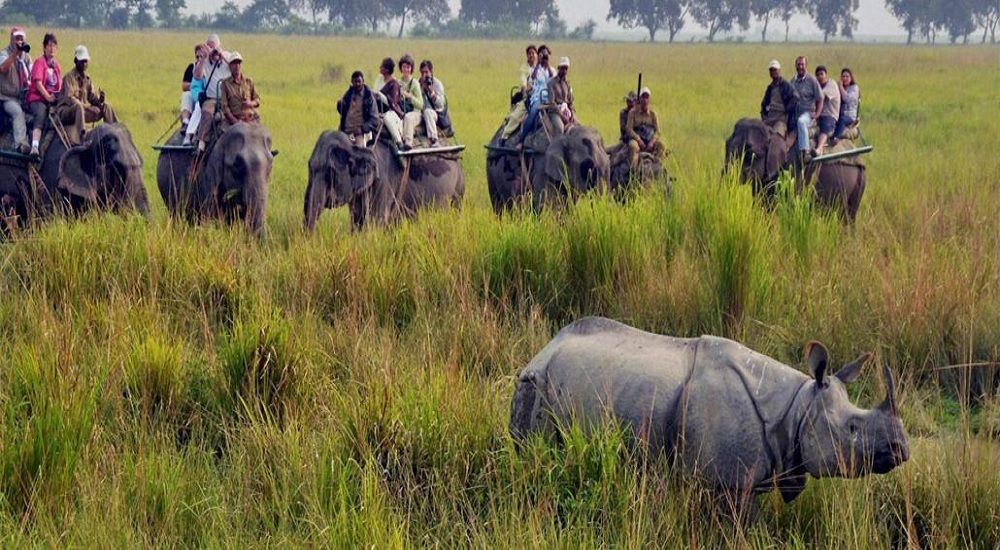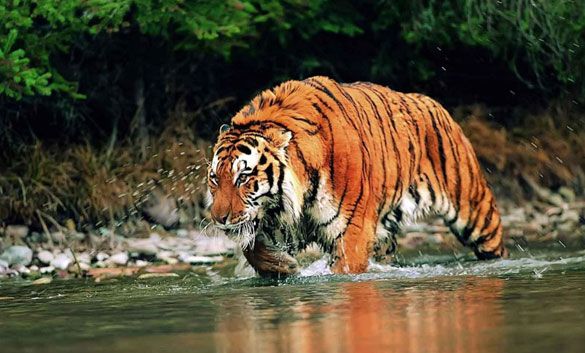🐘 Kaziranga National Park
Nestled in the heart of Assam, Kaziranga National Park is one of India’s most celebrated wildlife sanctuaries and a UNESCO World Heritage Site. Sprawled across the floodplains of the Brahmaputra River, this national park is world-famous for being home to the largest population of the Indian one-horned rhinoceros.

From its mist-covered grasslands to the echo of birdsong over wetlands, Kaziranga offers a rare glimpse into the raw, untamed beauty of the wild.
Kaziranga National Park is a world-renowned national park and a UNESCO World Heritage Site located in the state of Assam, India. It is one of the finest wildlife refuges globally and a major success story in conservation.

Here is a summary of the key information about Kaziranga National Park: for Kaziranga National Park
Kaziranga National Park Famous For:
- Great Indian One-Horned Rhinoceros: Kaziranga is the single largest stronghold of this endangered species, harboring about two-thirds of the world’s total population. The conservation of the rhino is its most celebrated achievement.
- The “Big Five”: The park is home to a spectacular collection of large mammals, collectively known as the “Big Five”:
- Great Indian One-Horned Rhino
- Royal Bengal Tiger (it has one of the highest densities of tigers in the world)
- Asiatic Elephant
- Wild Water Buffalo (it has the world’s largest population of this species)
- Eastern Swamp Deer (Barasingha)
Location and Geography: in Kaziranga National Park
- LocationN of Kaziranga National Park ortheast Indian state of Assam, spread across the districts of Golaghat and Nagaon.
- River: It is situated on the floodplains of the mighty Brahmaputra River.
- Habitat: The landscape is a mix of tall wet alluvial grasslands (often called elephant grass), alluvial savannah woodlands, tropical moist mixed deciduous forests, and numerous marshes and shallow pools (beels). The annual flooding of the Brahmaputra maintains the unique ecosystem.
Other Notable Wildlife of Kaziranga National Park
In addition to the “Big Five,” Kaziranga is a haven for rich biodiversity, including in Kaziranga National Park
- Mammals: Hoolock Gibbon (India’s only ape), Sloth Bear, Ganges River Dolphin (in its water bodies), Indian Leopard, Hog Deer, and various primates.
- Birds: It is recognized as an Important Bird Area (IBA), with over 478 species recorded, including many migratory birds from Central Asia during the winter, such as the Lesser Adjutant and Greater Adjutant Storks.
- Reptiles: King Cobra, Rock Python, Bengal Monitor, and various turtle species.
Key Facts and History for Kaziranga National Park
- Status: UNESCO World Heritage Site (inscribed in 1985), National Park (declared in 1974), and Tiger Reserve (declared in 2007).
- Establishment: First established as a Proposed Reserved Forest in 1905 to protect the rapidly dwindling population of the one-horned rhinoceros.
- Tourism: Popular for wildlife safaris, offering both Jeep Safaris and Elephant Safaris in its four ranges: Kohora (Central), Bagori (Western), Agaratoli (Eastern), and Burapahar.
- Best Time to Visit: November to April when the climate is mild and dry. The park is often closed from May to October due to heavy monsoon flooding.
🌿 A Quick Overview
- Location: Golaghat and Nagaon districts, Assam, India
- Established: 1905 (as a Reserve Forest), declared a National Park in 1974
- UNESCO Status: World Heritage Site since 1985
- Area: Around 430 sq km
- Famous For: One-horned rhinoceros, tigers, elephants, swamp deer, wild buffaloes, and migratory birds
🦏 Wildlife in Kaziranga of Kaziranga National Park
Kaziranga is often called the “Serengeti of the East.” It shelters a spectacular variety of wildlife:
- One-Horned Rhinoceros: The park houses nearly two-thirds of the world’s population.
- Royal Bengal Tigers: Kaziranga is also a Tiger Reserve and boasts one of the highest tiger densities in India.
- Elephants, Wild Buffaloes & Swamp Deer: The other members of the park’s famed “Big Five.”
- Birdlife: Over 480 bird species, including pelicans, storks, eagles, and migratory ducks.
The park’s diverse ecosystem of grasslands, marshes, and forests makes it a haven for both herbivores and predators.
🚙 Safari Experience in Kaziranga
There are two types of safaris in Kaziranga:
1. Jeep Safari
- The most popular way to explore the park.
- Available in all ranges — Kohora, Bagori, Agoratoli, and Burapahar.
- Ideal for spotting rhinos, elephants, and birds.
2. Elephant Safari
- Conducted in the early morning hours.
- Gives you a closer and unique view of rhinos and deer in their natural habitat.
- Best experienced at Central Range (Kohora) and Western Range (Bagori).
📍 Safari Zones
| Range | Location | Highlights |
|---|---|---|
| Kohora (Central Range) | Main entry point | Great for rhinos, elephants, and birds |
| Bagori (Western Range) | Near Bokakhat | Best for rhino sightings and elephant safaris |
| Agoratoli (Eastern Range) | Near Bokakhat | Famous for birdwatching and tigers |
| Burapahar (Southern Range) | Near Nagaon | Scenic trails and trekking opportunities |
🕒 Best Time to Visit
| Season | Months | Highlights |
|---|---|---|
| Winter (Nov – Feb) | Pleasant weather, great for safaris and birdwatching | |
| Summer (Mar – May) | Fewer crowds, animals visible near waterholes | |
| Monsoon (Jun – Oct) | Park closed due to flooding, not ideal for visits |
Tip: The park remains open for tourists from November to April.
🏨 Where to Stay
Kaziranga offers a variety of stays — from eco-lodges to luxury resorts:
- Kaziranga Resort – For comfortable and scenic stays near the park.
- IORA – The Retreat – Premium property with great facilities.
- Wild Grass Lodge – Popular with wildlife photographers and backpackers.
- Forest Rest Houses – Managed by the Assam Forest Department, ideal for budget travelers.
🍛 Local Cuisine to Try
After an adventurous safari, savor traditional Assamese dishes like:
- Khar – A signature Assamese preparation with raw papaya and pulses.
- Masor Tenga – Tangy fish curry.
- Pitha and Laru – Traditional sweets.
- And don’t miss the Assam tea served fresh from nearby plantations!
🧭 How to Reach Kaziranga
- By Air: Nearest airport – Jorhat (97 km) or Guwahati (217 km).
- By Train: Nearest railway station – Furkating (75 km).
- By Road: Well-connected by NH37 from Guwahati, Tezpur, and Jorhat.
🌸 Responsible Travel Tips
- Avoid plastic inside the park.
- Maintain silence during safaris.
- Don’t feed or disturb animals.
- Hire certified guides and support local communities.
📸 Must-Do Experiences in Kaziranga
- Go on both morning and afternoon safaris.
- Visit the Kaziranga National Orchid and Biodiversity Park.
- Explore nearby villages for local handicrafts.
- Take a river cruise on the Brahmaputra for scenic views and birdwatching.
✨ Final Thoughts
Kaziranga National Park is more than just a wildlife destination — it’s a celebration of nature’s resilience. Watching a one-horned rhino graze peacefully at sunrise or spotting a tiger’s pawprint on a muddy trail reminds you of the delicate balance of life in the wild.
Whether you’re a wildlife photographer, a nature enthusiast, or a family traveler, Kaziranga promises an unforgettable journey into the wild heart of Assam.
Tags: #KazirangaNationalPark #AssamTravel #WildlifeTourism #IndiaTravelBlog #OneHornedRhino
Pingback: Ranthambore National Park -Safari, Resorts & Travel in 2026